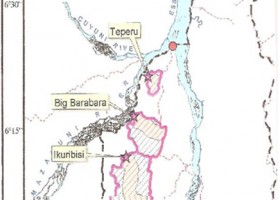If yuh plant plantain, yuh can’t reap cassava. (You reap what you sow) Guyanese Proverb
Overview
In a previous column on November, 23, 2009 titled “Development areas”, I introduced a development plan for the Bartica Triangle and Region Seven. The current issues regarding the mining industry demonstrated that the government did not conduct proper stakeholder discussions, which translates to completely ignoring this sector and the people. We must put major emphasis on further developing these areas versus looking at ways to shut it down. Guyana’s resources must be allowed to be extracted and used in an environmentally friendly way for further development of our nation versus waiting for handouts from countries such as Norway or selling them for higher prices to countries such as Iran that may be interested in our uranium potential.

Economic zone
This area must become a major economic zone for Guyana. This is the area west of the Essequibo River. It is accessible by river and road. The Bartica-Potaro Road passes through the area on the watershed between the Mazaruni and the Essequibo Rivers. The Bartica Township occupies the apex of the Bartica Triangle.
We must also look at returning some of the lands to major agriculture development and with the energy solutions proposed below, move into large-scale production in areas such as citrus. In the 1950s, the Lima Estate near Agatash village, exported barrels of lime-juice to England. Industries such as these create jobs for those who do not want to go into mining.

Developing new major roads into our forest and asphalting existing major roads, as one logger told me, will also create new tourism opportunities. In addition, the miners should be part of rebuilding our environment such as re-planting trees that may have been destroyed. Certain areas in this zone should also be protected from any mining. This is a beautiful region and a major tourism opportunity waiting to be developed in a sustainable fashion.
Energy sources for development
Bartica has a unique value in areas such as eco-tourism and forestry. In 2003, a German study looked at hydropower sites at Ikuribisi and Big Barabara which were considered critical to the future development of Barticia and Region Seven. Had we focused on these projects, today many of the tourist operators would have had clean, cheap renewable energy for the resorts and populations in the vicinity. There are many mini-hydro projects that we need to get implemented in these areas.
The Ikuribisi Falls which is located about 29km upstream of Bartica was identified as a key project. The government keeps waiting for the big one when many of these smaller hydro projects could have been completed. Some of these studies go back to 1984 and the site at Barabara could have produced 170kw. These projects can significantly improve the Bartica Triangle and make this area a key development zone for our nation.
Bartica is an area that we need to develop as a major hub for both mining and agriculture. It was once known for its peanuts, but lack of infrastructure has destroyed this industry
Conclusion
Guyana is a land bursting with opportunities for environmentally friendly economic development. Last year, miners officially declared 300,000 ounces of gold with a projected of 500,000 ounces this year. Rather than arbitrarily issuing moratoriums to the miners the government should enforce the regulations already on the books, hold real consultations with stakeholders on any proposed changes, get out of the way of potential investors in renewable energy, genially create a regime which encourages business investment and implement real reforms to give residents local control of where they live and work. We must have a longer view of what a budget of a nation should look like as the 2010 debates start. The long-term plans of what we would like to see this region and others look like must be discussed. Our focus must be on the creation of jobs, diversification of the economy and ensuring that the lives of our citizens are getting better and not pushing such dictatorial policies as recently targeted at miners.
The essential point of our plan for this region is we need to consider carefully our resource endowments before we make massive commitments. For example, if the government had studied Guyana’s resource capacities, it would have already been targeting holistic renewable energy capabilities rather than looking for one silver bullet energy project. Here we have an example of a German study supporting our call for localized hydroelectricity plants. This will serve to keep long-term unit cost down as the power generated per fixed/sunken investment costs is reduced. Moreover, a holistic renewable energy strategy also addresses the need to diversify production into manufacturing. For example, ethanol and bio-diesel are manufactured goods. Simultaneously, we build infrastructure and create long-term jobs.
Let us put the right plans in place so we can reap the true benefits of sustained development. Until next time “Roop”
Send comments to peter.ramsaroop @gmail.com




